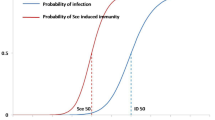Abstract
When directly transmitted infectious diseases are modeled assuming an everlasting induced immunity (and constant contact rate), there are well-established formulas to deal with, which is not true if we include the loss of induced immunity. In general, the immunity induced by the disease is everlasting. We propose a model considering the loss of immunity and present methods for the estimation of two epidemiological parameters: the force of infection and the basic reproduction ratio. We also analyze the effects of the loss of immunity on these parameters. Based on these results, we conclude that reinfection can play an important role in highly vaccinated populations.
Similar content being viewed by others
References
Anderson, R. M. and R. M. May (1991). Infectious Diseases of Humans: Dynamics and Control. Oxford: Oxford University Press.
Azevedo Neto, R. S., A. S. B. Silveira, D. J. Nokes, H. M. Yang, S. D. Passos, M. R. D. Cardoso and E. Massad (1994). Rubella Seroepidemiology in a Non-immunized Population of São Paulo State, Brazil. Epidemiol. Infect. 113, 161–173.
Bates, D. M. and D. G. Watts (1988). Nonlinear Regression Analysis and Its Applications. New York: Wiley.
Coutinho, F. A. B., E. Massad, M. N. Burattini, H. M. Yang, and R. S. Azevedo Neto (1993). Effects of vaccination programmes on transmission rates of infections and related threshold conditions for control. IMA J. Math. App. Med. Biol. 10, 187–206.
Diekmann, O., K. Dietz, and J. A. P. Heesterbeek (1991). The basic reproduction ratio for sexually transmitted diseases: I. theoretical considerations. Math. Biosc. 107, 325–339.
Dietz, K. (1975). Transmission and control of arbovirus diseases, in D. Ludwig and K. L. Cooke (Eds), Proceedings of SIMS Conference on Epidemiology, Alta, Utah, July 8–12, 1974, Philadelphia: Society for Industrial and Applied Mathematics, pp. 104–121.
Griffel, D. H. (1981). Applied Functional Analysis. New York: Wiley.
Liu, W. M., H. W. Hethcote and S. A. Levin (1987). Dynamical behavior of epidemiological models with nonlinear incidence rates. J. Math. Biol. 25, 359–380.
Markowitz, L. E., S. R. Preblud, P. E. Fine, et al (1990). Duration of live measles vaccine-induced immunity. Pediatr. Infect. Dis. J. 9, 101–110.
Massad, E., M. N. Burattini, R. S. Azevedo Neto, H. M. Yang, F. A. B. Coutinho and D. M. T. Zanetta (1994). A model-based design of a vaccination strategy against rubella in a non-immunized community of São Paulo State, Brazil. Epidemiol. Infect. 112, 579–594.
Massad, E., R. S. Azevedo Neto, M. N. Burattini et al. (1994). Assessing the efficacy of a mixed vaccination strategy against rubella in São Paulo, Brazil. Intern. J. Epidemiol. 24, 842–850.
Mathias, R. G., W. G. Meekison, T. A. Arcand, et al. (1989). The role of secondary vaccine failures in measles outbreaks. Amer. J. Public Health 79, 475–478.
Muench, H. (1959). Catalytic Models in Epidemiology. Cambridge, MA: Harvard University Press.
Press, W. H., B. P. Flannery, S. A. Teukolsky and W. T. Vetterling (1989). Numerical Recipes: The Art of Scientific Computing (FORTRAN Version). Cambridge: Cambridge University Press.
Raimundo, S. M., H. M. Yang and R. C. Bassanezi (1996). Modeling interaction between AIDS and tuberculosis: case study among women inmates, in Abstracts 3rd European Conference on Mathematics Applied to Biology and Medicine. 174.
Rouderfer, V., N. G. Becker and H. W. Hethcote (1994). Wanning immunity and its effects on vaccination schedules. Math. Biosc. 124, 59–82.
Tricomi, F. G. (1985). Integral Equations, New York: Dover.
Yang, H. M. (1997). Directly transmitted infections modeling considering age-structured contact rate—part I: stochastic derivation. Theor. Pop. Biol. submitted.
Yang, H. M., A. S. B. Silveira and E. Massad (1996). Modeling the directly transmitted infections considering the loss of immunity, A. Stevens and W. Jäger (Eds), in Abstracts 3rd European Conference on Mathematics Applied to Biology and Medicine. 179. Heidelberg: Universität Heidelberg.
Yang, H. M. and F. A. B. Coutinho (1998). Acquired immunity on a schistosomiasis transmission model—analysis of the stabilizing effects. J. Theoret. Biol., in press.
Yang, H. M., F. A. B. Coutinho and E. Massad (1997). Acquired immunity on a schistosomiasis transmission model—fitting the data. J. Theoret. Biol., in press.
Yang, H. M. (1997). Impacto da Vacinação nas Infecções de Transmissão Direta—Epidemiologia Através de Modelo Matemático (port.). Thesis. IMECC-UNICAMP.
Author information
Authors and Affiliations
Rights and permissions
About this article
Cite this article
Yang, H.M., Silveira, A.S.B. The loss of immunity in directly transmitted infections modeling: Effects on the epidemiological parameters. Bull. Math. Biol. 60, 355–372 (1998). https://doi.org/10.1006/bulm.1997.0031
Received:
Accepted:
Issue Date:
DOI: https://doi.org/10.1006/bulm.1997.0031




